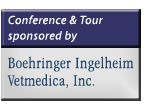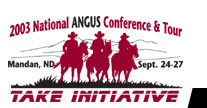|
|

"Take it to the Bank"
Barry Dunn, South Dakota State University
Click here to view the presentation (in PowerPoint format). Click here to listen to the presentation
You will need Windows Media Player to listen in.
Click here to download a free version.
How do you measure profit?
Iowa State University (ISU) ag economist Earl Heady said in 1952, "Net profit (net income) can no longer be used as a gauge of whether resources are used efficiently." But most folks in agriculture have continued to misuse net income for the past 51 years, said Barry Dunn, South Dakota State University (SDSU) ag economist, as he addressed attendees of the 2004 National Angus Conference Sept. 25 in Mandan, N.D.
Cattlemen usually think of profit as net income, which is gross revenue minus total expenses adjusted for inventory. The problem of using it as a measure of efficiency is that there is no denominator, Dunn said. Net income, similar to pounds gained, is a measure of output. To calculate efficiency, you have to have a denominator – the pounds of feed it took to get the gain.
Dunn said a more appropriate definition of profit efficiency is return on assets (ROA). Calculated by dividing net income by the investment it took to obtain that income, ROA is a measure of managerial efficiency, he said.
"Profit is determined by a set of relationships," Dunn said. Return on assets is dependent on the relationship among asset investment, annual expenses and value received in the marketplace.
"Double-digit return on assets should be the goal for every one of you," he told attendees.
Dunn provided an example (on a per cow basis) where $425 gross income, $385 total expenses and $2,300 in assets provided an ROA of 2%. By lowering expenses to $250 and investment in assets to $1,500, an ROA of 10% could be achieved even with a lowered income of $400.
Producers can withstand a higher annual cow cost if they have a low investment and/or good marketing, he explained, citing specific examples. Producers with high investment costs can also achieve double-digit ROAs by putting pressure on cow costs and exceptional marketing.
Cattlemen have lots of room to improve, Dunn said. The average ROA for businesses in the United States is about 10%. The average ROA for cattle enterprises across the nation is 2%-3%.
"That's not a competitive business. If you want to really get to the roots of rural out-migration," Dunn said, "this in my opinion is the driver – we're noncompetitive in our business.
"In a competitive, capitalistic economy, you don't have a choice to stay at a 2% or 3% return on assets and watch your kids leave home or leave the community and wonder why. If we want to be competitive, if we want to stabilize this industry, we need to be profitable."
Dunn presented an overview of field research using Standardized Performance Analysis (SPA) standards to evaluate the factors affecting profitability of 148 herds. ROA on the low-profit 16% of the herds averaged 15.5%, while the ROA of the high-profit 16% of the herds averaged 18.2%.
Listen to the audio of Dunn's presentation while paging through his PowerPoint to discover the characteristics of high-profit producers.
— by Shauna Rose Hermel
 |
| "If you want to be competitive, you need to be profitable," Barry Dunn told Angus enthusiasts at the 2003 National Angus Conference. "Double-digit returns should be the goal for everyone. There is tremendous potential in this business." |
|



|




